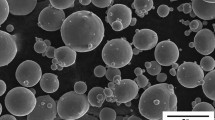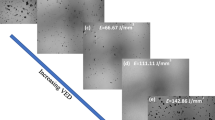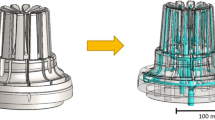Abstract
Laser powder bed fusion (LPBF) has been widely used to manufacture intricate geometries that would otherwise be costly to conventionally manufacture due to the complexity of design and the hard-to-machine nature of Ni-based superalloys such as IN625. However, the advantage of LPBF is opposed by the formation of high tensile residual stresses (RS), poor surface quality, and dimensional accuracy, which would require several post-processes to correct these drawbacks. This work evaluates the possibility of reducing the number of post-processing steps by using drilling to improve both the RS and geometrical accuracy of printed holes compared to the widely used post-process laser peening (LP). First, both conventional drilling and low-frequency vibration-assisted drilling (LF-VAD) were carried out on a printed plate with differently sized pilot holes, using a range of cutting parameters to determine the optimum cutting parameters. Next, the geometrical accuracy, surface roughness, microhardness, and in-depth RS were measured compared to as-built and LP holes. Drilling had the combined advantage of improving the hole accuracy compared to the undersized as-built holes, increasing the microhardness and inducing in-depth compressive RS. However, although LP induced high compressive RS, it had no beneficial effect on the geometric accuracy or surface roughness except the deeper depth of the compressive RS layer compared to the drilling process.











Similar content being viewed by others
Data availability
All the related data are available in the manuscript.
Abbreviations
- AB:
-
As-built
- AM:
-
Additive manufacturing
- LF-VAD:
-
Low-frequency vibration-assisted drilling
- LPBF:
-
Laser powder bed fusion
- LP:
-
Laser peened
- RS:
-
Residual stress
- VAD:
-
Vibration-assisted drilling
- A m :
-
Vibration amplitude (mm)
- f :
-
Feed rate (mm/rev)
- h :
-
Hatch spacing (mm)
- N :
-
Cutting speed (rpm)
- P :
-
Power (W)
- t :
-
Layer thickness (mm)
- v :
-
Scan speed (mm/s)
- Φ pilot :
-
Pilot hole diameter (mm
References
Marchese G, Garmendia Colera X, Calignano F, Lorusso M, Biamino S, Minetola P et al (2017) Characterization and comparison of Inconel 625 processed by selective laser melting and laser metal deposition. Adv Eng Mater 19:1600635
Dinda G, Dasgupta A, Mazumder J (2009) Laser aided direct metal deposition of Inconel 625 superalloy: microstructural evolution and thermal stability. Mater Sci Eng A 509:98–104
Ezugwu E, Wang Z, Machado A (1999) The machinability of nickel-based alloys: A review. J Mater Process Technol 86:1–16
Balbaa M, Elbestawi M, McIsaac J (2019) An experimental investigation of surface integrity in selective laser melting of Inconel 625. Int J Adv Manuf Technol 104:3511–3529
Yakout M, Cadamuro A, Elbestawi M, Veldhuis SC (2017) The selection of process parameters in additive manufacturing for aerospace alloys. Int J Adv Manuf Technol 92:2081–2098
Yakout M, Elbestawi M, Veldhuis SC (2018) Process-structure-property relationship for selective laser melting of aerospace alloys. in The 7th International Conference on Virtual Machining Process Technology (VMPT)
Mueller D, Mueller H (2000) Experiences using rapid prototyping techniques to manufacture sheet metal forming tools. in Proc. ISATA Conference, Dublin 25–27
Yakout M, Elbestawi M, Wang L, Muizelaar R (2019) Selective laser melting of soft magnetic alloys for automotive applications. in Joint Special Interest Group meeting between euspen and ASPE
Choi J, Mazumder J (2001) Rapid manufacturing by laser aided direct metal deposition process: issues and examples. in International Design Engineering Technical Conferences and Computers and Information in Engineering Conference 333–338
Mahmoud D, Elbestawi MA (2017) Lattice structures and functionally graded materials applications in additive manufacturing of orthopedic implants: a review. Journal of Manufacturing and Materials Processing 1:13
Mahmoud D, Elbestawi M (2019) Selective laser melting of porosity graded lattice structures for bone implants. Int J Adv Manuf Technol 100:2915–2927
Karabulut Y, Kaynak Y (2020) Drilling process and resulting surface properties of Inconel 718 alloy fabricated by selective laser melting additive manufacturing. Procedia CIRP 87:355–359
Kreitcberg A, Brailovski V, Turenne S (2017) Effect of heat treatment and hot isostatic pressing on the microstructure and mechanical properties of Inconel 625 alloy processed by laser powder bed fusion. Mater Sci Eng A 689:1–10
Balbaa M, Ghasemi A, Fereiduni E, Elbestawi M, Jadhav S, Kruth JP (2020) Role of powder particle size on laser powder bed fusion processability of AlSi10Mg alloy. Addit Manuf 101630
Gu DD, Meiners W, Wissenbach K, Poprawe R (2012) Laser additive manufacturing of metallic components: materials, processes and mechanisms. Int Mater Rev 57:133–164
Wen S, Shin YC (2011) Modeling of transport phenomena in direct laser deposition of metal matrix composite. Int. J Heat Mass Transf 54:5319–5326
Tian Z, Zhang C, Wang D, Liu W, Fang X, Wellmann D et al (2020) A review on laser powder bed fusion of inconel 625 nickel-based alloy. Appl Sci 10:81
Jiang J, Xu X, Stringer J (2018) Support structures for additive manufacturing: a review. Journal of Manufacturing and Materials Processing 2:64
DonachieDJ, Donachie SJ(2002) Superalloys: a technical guide: ASM International
Suave LM, Bertheau D, Cormier J, Villechaise P, Soula A, Hervier Z (2014) Impact of thermomechanical aging on alloy 625 high temperature mechanical properties. in 8th International Symposium on Superalloy 718 and Derivatives 317–331
Das S, Wohlert M, Beaman JJ, Bourell DL (1997) Direct selective laser sintering and containerless hot isostatic pressing for high performance metal components. in 1997 International Solid Freeform Fabrication Symposium
Gillespie LK (2017) Design for Advanced manufacturing: technologies and processes: McGraw-Hill Education
Authors V (1994) ASM Handbook Volume 5: Surface Engineering, ed: ASM International, Materials Park, Ohio, USA
Ardi DT, Guowei L, Maharjan N, Mutiargo B, Leng SH, Srinivasan R (2020) Effects of post-processing route on fatigue performance of laser powder bed fusion Inconel 718. Addit Manuf 36:101442
Lesyk D, Dzhemelinskyi V, Martinez S, Mordyuk B, Lamikiz A (2021) Surface shot peening post-processing of inconel 718 alloy parts printed by laser powder bed fusion additive manufacturing. J Mater Eng Perform 30:6982–6995
Maleki E, Unal O, Guagliano M, Bagherifard S (2021) The effects of shot peening, laser shock peening and ultrasonic nanocrystal surface modification on the fatigue strength of Inconel 718. Mater Sci Eng A 810:141029
Hussein R (2019) Vibration assisted drilling of carbon fiber reinforced polymer and titanium alloy for aerospace application
Kuo C, Li Z, Wang C (2017) Multi-objective optimisation in vibration-assisted drilling of CFRP/Al stacks. Compos Struct vol. 173, pp. 196–209, 08 Jan 2017
Xu J, Li C, Chen M, Ren F (2019) A comparison between vibration assisted and conventional drilling of CFRP/Ti6Al4V stacks. Mater Manuf Process 34:1182–1193
Hussein R, Sadek A, Elbestawi MA, Attia MH (2019) Surface and microstructure characterization of low-frequency vibration-assisted drilling of Ti6Al4V. Int J Adv Manuf Technol 103:1443–1457
Li S, Zhang D, Liu C, Tang H (2020) Exit burr height mechanistic modeling and experimental validation for low-frequency vibration-assisted drilling of aluminum 7075-T6 alloy. J Manuf Process 56:350–361, 08 Jan 2020
Liao YS, Chen YC, Lin HM (2007) Feasibility study of the ultrasonic vibration assisted drilling of Inconel superalloy. Int J Mach Tools Manuf 47:1988–1996, 10 Jan 2007
Chen S, Zou P, Tian Y, Duan J, Wang W (2019) Study on modal analysis and chip breaking mechanism of Inconel 718 by ultrasonic vibration-assisted drilling. Int J Adv Manuf Technol 105:177–191
MITIS Engineer. MITIS Tool Holder. Available: https://www.mitis.fr/
Y.-C. group. YG-1 CANADA GROUP. Available: http://www.yg1.ca/
Gradl PR, Tinker DC, Ivester J, Skinner SW, Teasley T, Bili JL (2021) Geometric feature reproducibility for laser powder bed fusion (L-PBF) additive manufacturing with Inconel 718. Addit Manuf 47:102305
Gruber S, Grunert C, Riede M, López E, Marquardt A, Brueckner F (2020) Comparison of dimensional accuracy and tolerances of powder bed based and nozzle based additive manufacturing processes. J Laser Appl 32:032016
Bono M, Ni J (2001) The effects of thermal distortions on the diameter and cylindricity of dry drilled holes. Int J Mach Tool Manuf 41:2261–2270
Hussein R, Sadek A, Elbestawi MA, Attia M (2018) Low-frequency vibration-assisted drilling of hybrid CFRP/Ti6Al4V stacked material. Int J Adv Manuf Technol 98:2801–2817
Ezugwu E, Tang S (1995) Surface abuse when machining cast iron (G-17) and nickel-base superalloy (Inconel 718) with ceramic tools. J Mater Process Technol 55:63–69
Thakur DG, Ramamoorthy B, Vijayaraghavan L (2012) Effect of cutting parameters on the degree of work hardening and tool life during high-speed machining of Inconel 718. Int J Adv Manuf Technol 59:483–489
Pawade R, Joshi SS, Brahmankar P (2008) Effect of machining parameters and cutting edge geometry on surface integrity of high-speed turned Inconel 718. Int J Mach Tool Manuf 48:15–28
Rozmus-Górnikowska M, Kusiński J, Cieniek Ł (2020) Effect of laser shock peening on the microstructure and properties of the inconel 625 surface layer. J Mater Eng Perform 29:1544–1549
Balbaa M, Mekhiel S, Elbestawi M, McIsaac J (2020) On selective laser melting of Inconel 718: densification, surface roughness, and residual stresses. Mater Des 108818
Maroju NK, Pasam VK (2019) FE modeling and experimental analysis of residual stresses in vibration assisted turning of Ti6Al4V. Int J Precis Eng Manuf 20:417–425
Jinoop A, Subbu SK, Paul C, Palani I (2019) Post-processing of laser additive manufactured Inconel 718 using laser shock peening. Int J Precis Eng Manuf 20:1621–1628
Author information
Authors and Affiliations
Contributions
Mohamed Balbaa: conceptualization, methodology, investigation, writing — original draft, writing — review and editing. Ramy Hussein: conceptualization, methodology, investigation, writing — original draft, writing — review and editing. Lloyd Hackel: methodology, writing — review and editing. Mohamed Elbestawi: supervision, writing — review and editing.
Corresponding authors
Ethics declarations
Conflict of interest
The authors declare no competing interests.
Additional information
Publisher's Note
Springer Nature remains neutral with regard to jurisdictional claims in published maps and institutional affiliations.
Rights and permissions
About this article
Cite this article
Balbaa, M., Hussein, R., Hackel, L. et al. A novel post-processing approach towards improving hole accuracy and surface integrity in laser powder bed fusion of IN625. Int J Adv Manuf Technol 119, 6225–6234 (2022). https://doi.org/10.1007/s00170-022-08725-z
Received:
Accepted:
Published:
Issue Date:
DOI: https://doi.org/10.1007/s00170-022-08725-z




